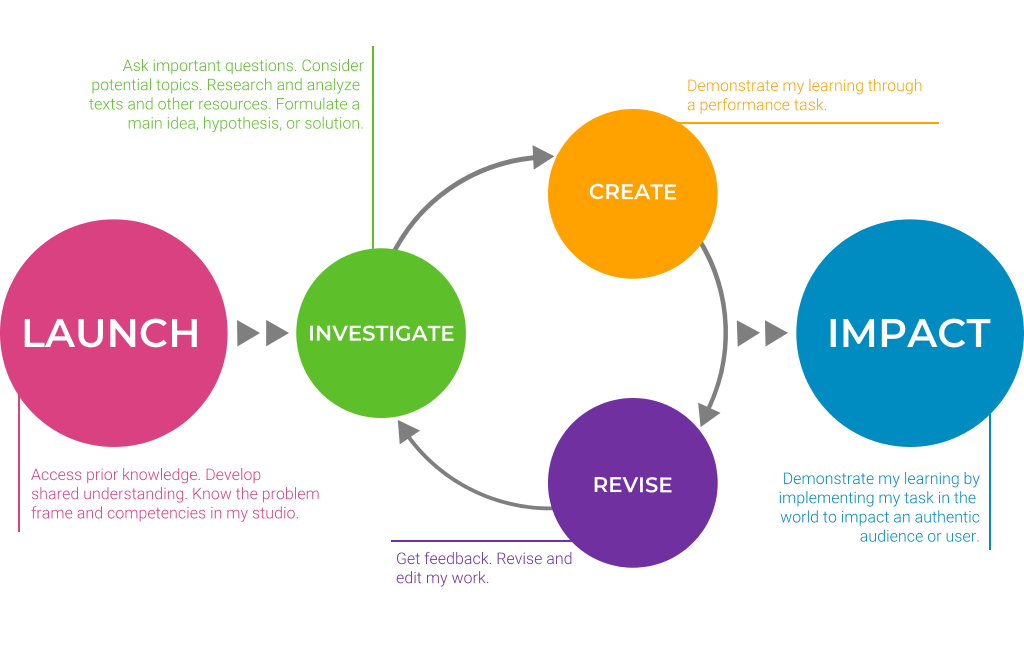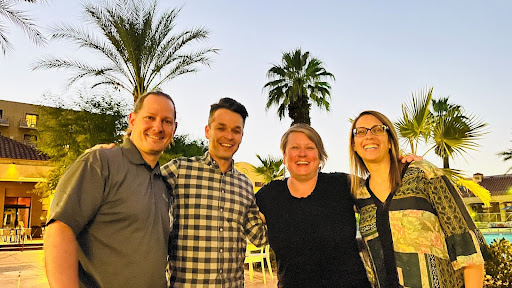Saturday mornings in my childhood often involved a bowl of Rice Krispies sprinkled with sugar and a cartoon marathon. One of my favorites was The Jetsons, a space-age family who lived in the Skypad Apartments building, mounted on a tall pole high above the ground in Orbit City. In fact, all the buildings in Orbit City were on top of high poles, necessitating vehicles to go anywhere. Flash forward a few decades, and as a teacher, I often felt like I worked in Orbit City, atop a high pole, too, separated and siloed from other teachers.
When I became a founding teacher of Building 21 Allentown, I moved from Orbit City and became part of a community of like-minded educators looking to transform education through competency-based education and personalized learning. This community extended when I participated in my first Building 21 Summer Design Institute (SDI) at Villanova University in the summer of 2016.
When I transitioned into my current role at the Building 21 Network, I was on the other side of the table as a 2022 SDI facilitator. I was now part of the team responsible for ensuring our participants felt connected and empowered to do the work of CBE. This past August, over 25 educators from Massachusetts to California gathered virtually to learn how to better design instruction around CBE. We worked together to develop the capacity to design studios and to be able to support others in this work.
One of the most powerful parts of facilitating was participating in the SDI reflection process. In this blog post, I examine what the participant reflection data told us about our own practices and how this can inform what’s next.
Our Takeaways
Glow #1: Collaboration Matters
First, we encouraged school leaders to send a cohort to SDI because wrestling with a new way of looking at instructional design is always better together. Then, we ensured these cohorts had blocks of time to collaborate on their studio design. If an educator did not have a cohort, we matched them with a team with similar goals.
First, we encouraged school leaders to send a cohort to SDI because wrestling with a new way of looking at instructional design is always better together. Then, we ensured these cohorts had blocks of time to collaborate on their studio design. If an educator did not have a cohort, we matched them with a team with similar goals. Ayris Sanders, Director of Lab School shares, “The Summer Design Institute provides more than an opportunity to develop problem-based, competency-based impactful curriculum designs, but it activates creativity, curiosity, connectedness, and collaboration for educators. Through this experience, educators, from all over the country, come together to work as critical friends and are pushed to challenge their mindsets to ensure our work is done with equity at its core. With the use of the Liberatory Design Mindsets, educators are encouraged to see, engage, and act. The collaboration of teams at SDI allows for educators to do more than ‘talk the talk’ about tackling equity, but it requires them to ‘walk the walk’.”
As teams worked together, the collaboration chain continued with coaching, which is what makes SDI different from many other instructional design opportunities. The instructional leaders from our Building 21 Lab Schools and the Learning Innovation Network supported SDI participants in designing studios for elementary, middle, and high school. One participant commented, “The one-on-one time with the coaches and the ability to share our documents was a significant benefit for me. We could work on the studio in real time and collaborate with multiple coaches if we needed to, which was great.” Another reflected, “We got to grapple in the messiness and get guidance along the way.” In fact, coaching was the highest-rated component of the institute.
The last links in our collaboration chain were small, cross-cohort feedback groups where teachers presented their draft designs to each other. After coaching, this was our second-highest rated SDI component. Participants followed a feedback protocol where they introduced their design, received feedback from their teammates, and then had time for an open discussion. One teacher said, “this was a great opportunity for everyone to share ideas. Even though our grade levels might not be the same, we still could help each other improve our studio or the components of our studio.”
Glow #2: Struggling Matters
The SDI focuses on supporting teachers in implementing instructional design within a competency-based model. We ask teachers to step back from traditional planning, which often centers on the project or test, and step into a CBE mindset. This means that you first need to know what competencies you are assessing and then design the culminating task around those particular skills. It’s only then you move into designing the day-to-day choreography teachers feel most comfortable in; however, there is a plot twist. In order to most support student learning in a CBE model, every activity must revolve around the teaching or practice of skills on the continua. This can cause some discomfort, and as we know, discomfort is part of the change process. This is why we talked about the Learning Pit.
Our goal with SDI participants, as with our students, was to challenge them while providing plenty of support. Sandra Moumoutjis, Executive Director of the Learning Innovation Network, introduced the idea of the Learning Pit to help participants see this in action and stressed the importance of embracing the struggle in learning how to implement CBE design.
“We all know what it feels like to be in the Learning Pit, but we don’t always know how to get out. It is through effort, practice, feedback, and collaboration that, both adults and students, find their way to eureka!”
If we want our students to be courageous enough to try something new, wrestle with roadblocks, and collaborate with others to seek answers, we need to be just as courageous in our learning, too. One participant said, “The Studio Design Institute really pushed me to get outside my comfort zone and approach curriculum development in an entirely new way. The backwards design process, the extensive feedback, and the helpful structure provided by the team all ensured that I developed a truly effective and engaging studio.” One of our facilitators, Bear St. Michael, echoed this sentiment by saying, “Problem-based learning isn’t just for our students. As a teacher, the opportunity to do real work, with coaching and support, is essential for meaningful teacher development. Whether you’re a facilitator or a participant, SDI is grounded in completing real, authentic work, and that made the experience so much more meaningful and valuable to me.”
Glow #3: Teacher Leadership Matters
We held the first SDI in the summer of 2016 at Villanova University, where staff from our two lab schools worked together to develop their instructional design skills, grow their understanding of equity, and create a fellowship. Fast-forward six years and some of our lab school staff now co-facilitate the SDI. This is the model of professional growth Building 21 strives for, where teachers become leaders. Teacher-leaders who stepped up to facilitate were:
Building 21 Allentown Lab School
- Shannon Salter, Founding Humanities Studio Educator and Partnership Coordinator
Building 21 Philadelphia Lab School
- Bear St. Michael, 9th Grade/Algebra1 Teacher
- Sara Grieb, ELA Educator
- Kathy Walsh, Science Educator
Their expertise in CBE, studio design, and personalized learning was invaluable and a tribute to the hard work they have put in with the students at our lab schools.
We also develop teacher leaders within our Learning Innovation Network. Jimmi Gonzalez is an English teacher at Central Academy in the West Ada School district in Meridian, Idaho, one of our Learning Innovation Hubs. Building 21 has been partners with West Ada for six years in their transition to a competency-based model, so Jimmi arrived at SDI with an advanced toolkit. When it was clear some participants were ready to extend their studio design skills, Jimmi agreed to hold a breakout session about turning studio guides into student-facing Google Sites. Jimmi reflected on the experience and said, “Greater than ideas is the ability and willingness to share them. The summer institute provided an opportunity for teachers to learn, share and develop great concepts for design.”
Our Grow: The Studio Planner

One of our core values is transparency, so along with celebrating successes, we must take action on areas of growth. Participant reflections made it clear our Studio Planner was the component of SDI that needed the most revision. Although some participants said they appreciated the opportunity to “brain dump” before using the Studio Guide, many found it did not match their thinking style or was too similar to the studio guide. Keeping this feedback in mind, we streamlined the studio planner to address these concerns.
Our team revised the studio planner and rolled it out during one of our sessions at the 2022 Aurora Institute Symposium. One of our reflection questions at the end of the Aurora session was “What is one thing you learned about in this workshop that you will share and/or try to implement?” Forty-two percent of respondents said they wanted to share the studio planner, and, as evidenced by the use of exclamation points in their reflections, we feel good about this version. Participants wrote, “I’m excited to take the Studio planning document to my leadership team to discuss the possibilities!” and another noted, “The studio planner is an answer to many questions our team has had! Thank you for the outline to help implement CBE!”
We are happy to now be able to share this revised studio planner with you in our Resource Library. All you need to do is sign up for a free Building 21 account and you’ll have access to not only this studio planner, but other resources, as well. If you try it and have feedback, we’d appreciate hearing about your experience.
Building 21’s mission is Empowering networks of learners to connect with their passion and build agency to impact their world. Using the word “learners” is intentional, since our work is not only about supporting children but also the adults who serve them. We want SDI to be a place where educators can connect with their passion and agency. We want to challenge our participants to try something new, be it learning studio design or shifting into facilitation roles. One of our participants explained the impact by reflecting, “Studio Design Institute has a way of creating a flow and space that teaches and models along with time to grapple with the work and receive coaching that is constructive, safe and encouraging.” Offering a Summer Design Institute is a way to leave the disjointed landscape of Orbit City behind and to connect with what matters most to all who take part: designing quality instruction so students can impact their today, their future, and the world around them.
So what’s next for the Learning Innovation Network?
Along with a 2023 Summer Design Institute, we are excited to announce we will be hosting a few workshops in 2023. Please stay tuned for more information so you can remain connected with the Learning Innovation Network and the talented, innovative educators leading the way in competency-based education and personalized learning.





We benefited from these glows and grows. Thank you!